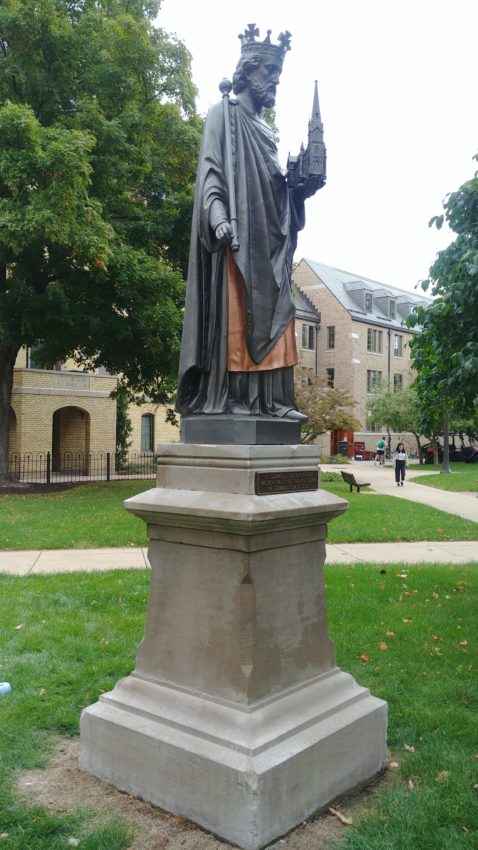The restoration of religious statuary, like other cultural heritage works or sites, involves careful assessment and treatment considerations. Many of the individuals who have been immortalized in earthly materials of metal or stone made great sacrifices during their lifetimes on the path to sainthood. In the late summer of 2019, Emmett Lodge, a NACE certified coatings inspector, in consultation with Thomas Podnar, Senior Sculpture Conservator, performed the restoration of a religious statue of Saint Edward from the University of Notre Dame.
Edward the Confessor was born to King Ethelred the Unready and his Norman queen, Emma, over a 1,000 years ago in England. During his lifetime he was said to have the power to heal the sick. Though his family history is fraught with battles and exile, Edward the Confessor became King in 1042 (and eventually named a saint in 1161). Despite an earlier promise to make a pilgrimage to Rome, his new royal duties made it nearly impossible. The Pope agreed to release him of this obligation if Edward created a monastery dedicated to St. Peter. The resulting cathedral became known as Westminster Abbey.
While there are many statues of Saint Edward around the world, one such statue is on the campus of the University of Notre Dame. The cast iron statue typically rests in front of the courtyard of St. Edward’s Hall on campus. Edward’s relics rest in the reliquary chapel in the nearby Basilica of the Scared Heart. St. Edward’s Hall, a men’s residence hall on campus, is named after the saint. Edward was the patron saint of Father Edward Sorin, C.S.C., founder of the University of Notre Dame.
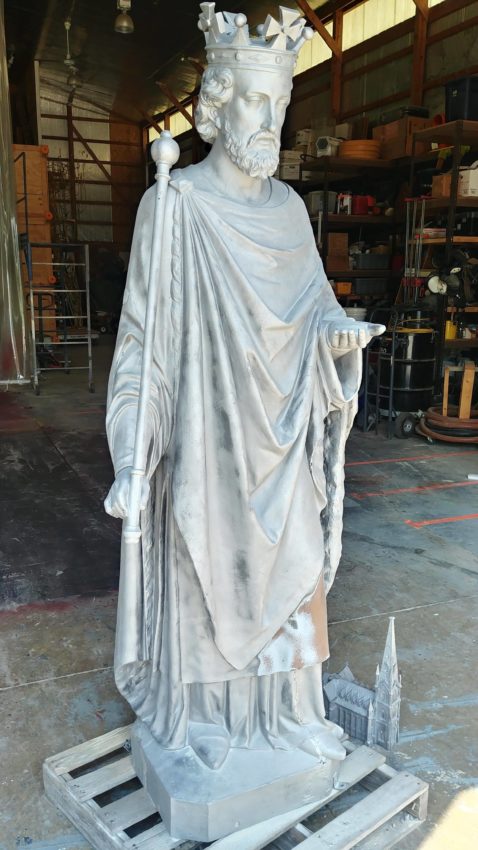
This statue of Saint Edward the Confessor is clad in long robes. He wears a large crown on his head and holds a scepter in one hand and a model of Basilica of the Sacred Heart in the other hand.
From years of exposure, the surface of the sculpture had moderate corrosion blooms throughout along with heavily chalked paint. It was clear that a full coating removal and recoating was required. The model mounting bolts rusted causing the model to detach. The statue was secured to its stone plinth by mild steel “L” brackets at some point in the past. Since these brackets were attached to the exterior of the sculpture’s base, they were both visually undesirable and structurally insufficient to safely hold the figure onto the stone plinth.
After a visual inspection and historical research, the previous paint system was identified as a metallic single stage topcoat with an unidentified primer. There was no evidence of original paint layers; therefore, the sculpture had likely been abrasive blasted at some point in the past. Preparing the surface for a new, durable coating was considered the most suitable conservation treatment option considering the sculpture would be displayed outdoors.
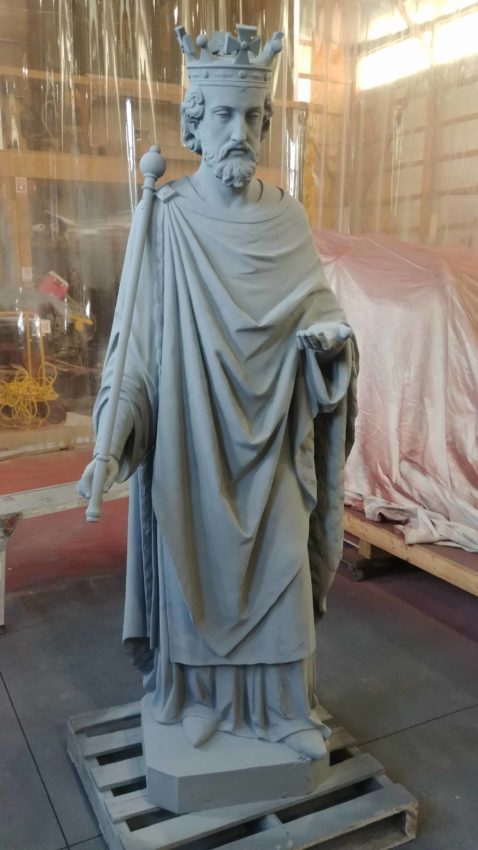
The sculpture was deinstalled and transported to the McKay Lodge Conservation Laboratory just outside of Cleveland, Ohio in order to conserve the sculpture. Restoration of the religious statuary began with removing all coatings to bare metal. Media-blasting was performed to reduce the previously applied coatings and corrosion, while allowing the details of metal casting to remain intact. New coatings would be applied with a primer and top coat, but repairs were also needed.
In consultation with the client and archive images of the original color scheme, new colors were selected for a coating suitable for outdoors that would also provide the desired aesthetic.
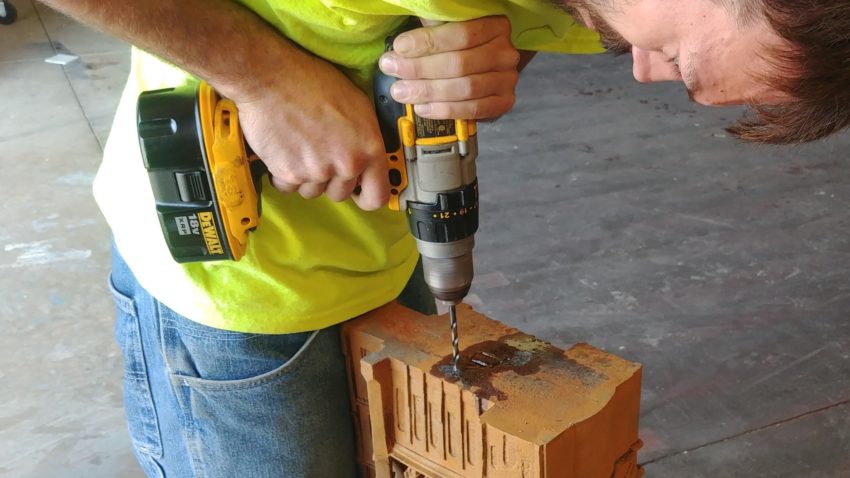
The broken and corroded model mounting bolts were removed from the hand. New bolt holes were drilled and tapped into the model, and new stainless-steel countersunk screws were used to reattach the model to the hand.
With the colors perfected and the repairs made, Emmett Lodge applied the new coatings. After the restoration of the religious statuary, the sculpture of St. Edward once again appears to don robes of copper and silver.
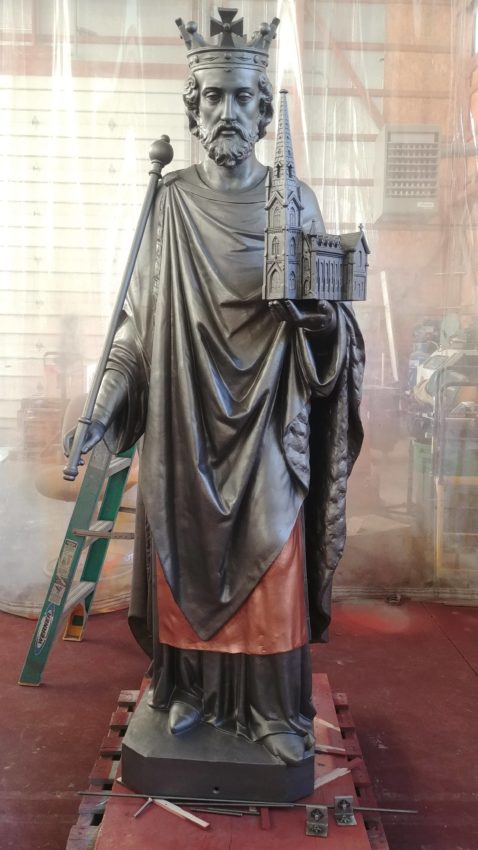
The sculpture was reinstalled onto its stone plinth on the campus of the University of Notre Dame. It is now in stable condition, and its appearance is greatly approved; the sculpture of Saint Edward can be viewed in its original location in the courtyard in front of St. Edward’s Hall.
